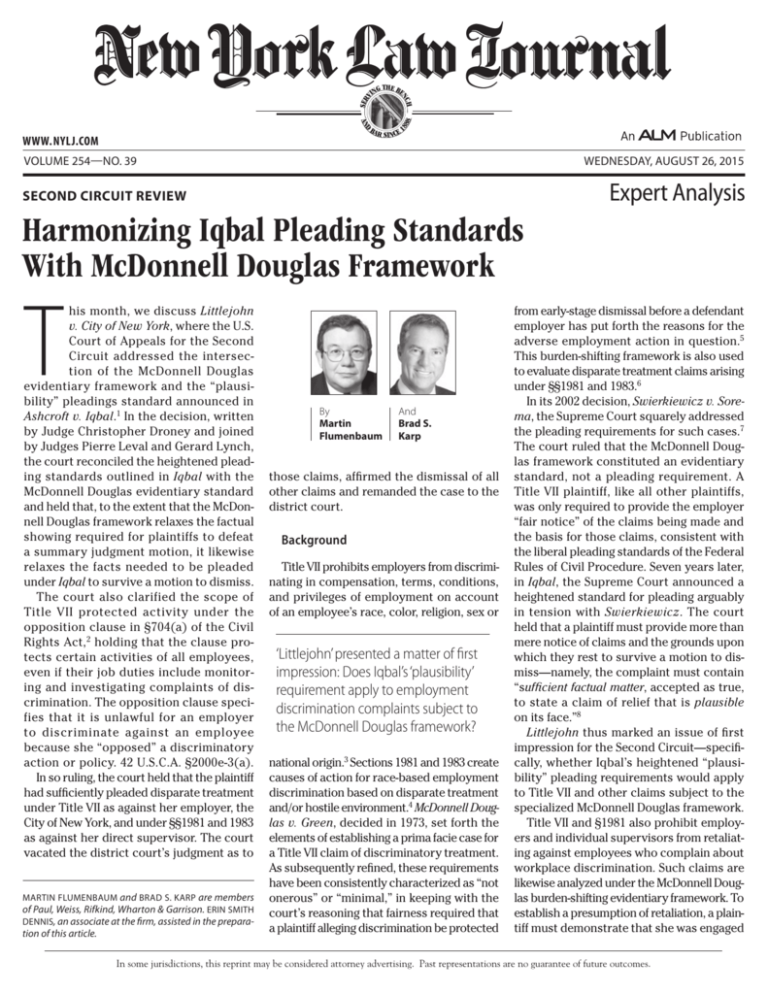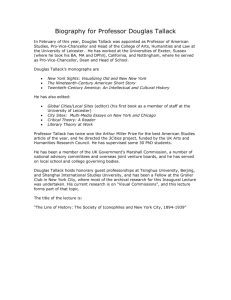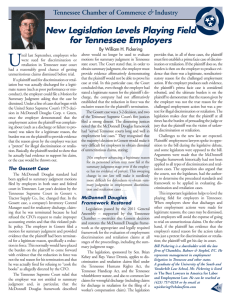
AND
88
8
SER
V
H
NC
THE BE
ING
1
BA
R SINCE
www. NYLJ.com
Wednesday, August 26, 2015
Volume 254—NO. 39
Expert Analysis
second circuit review
Harmonizing Iqbal Pleading Standards
With McDonnell Douglas Framework
T
his month, we discuss Littlejohn
v. City of New York, where the U.S.
Court of Appeals for the Second
Circuit addressed the intersection of the McDonnell Douglas
evidentiary framework and the “plausibility” pleadings standard announced in
Ashcroft v. Iqbal.1 In the decision, written
by Judge Christopher Droney and joined
by Judges Pierre Leval and Gerard Lynch,
the court reconciled the heightened pleading standards outlined in Iqbal with the
McDonnell Douglas evidentiary standard
and held that, to the extent that the McDonnell Douglas framework relaxes the factual
showing required for plaintiffs to defeat
a summary judgment motion, it likewise
relaxes the facts needed to be pleaded
under Iqbal to survive a motion to dismiss.
The court also clarified the scope of
Title VII protected activity under the
opposition clause in §704(a) of the Civil
Rights Act,2 holding that the clause protects certain activities of all employees,
even if their job duties include monitoring and investigating complaints of discrimination. The opposition clause specifies that it is unlawful for an employer
to discriminate against an employee
because she “opposed” a discriminatory
action or policy. 42 U.S.C.A. §2000e-3(a).
In so ruling, the court held that the plaintiff
had sufficiently pleaded disparate treatment
under Title VII as against her employer, the
City of New York, and under §§1981 and 1983
as against her direct supervisor. The court
vacated the district court’s judgment as to
Martin Flumenbaum and Brad S. Karp are members
of Paul, Weiss, Rifkind, Wharton & Garrison. Erin Smith
Dennis, an associate at the firm, assisted in the preparation of this article.
By
Martin
Flumenbaum
And
Brad S.
Karp
those claims, affirmed the dismissal of all
other claims and remanded the case to the
district court.
Background
Title VII prohibits employers from discriminating in compensation, terms, conditions,
and privileges of employment on account
of an employee’s race, color, religion, sex or
‘Littlejohn’ presented a matter of first
impression: Does Iqbal’s ‘plausibility’
requirement apply to employment
discrimination complaints subject to
the McDonnell Douglas framework?
national origin.3 Sections 1981 and 1983 create
causes of action for race-based employment
discrimination based on disparate treatment
and/or hostile environment.4 McDonnell Douglas v. Green, decided in 1973, set forth the
elements of establishing a prima facie case for
a Title VII claim of discriminatory treatment.
As subsequently refined, these requirements
have been consistently characterized as “not
onerous” or “minimal,” in keeping with the
court’s reasoning that fairness required that
a plaintiff alleging discrimination be protected
from early-stage dismissal before a defendant
employer has put forth the reasons for the
adverse employment action in question.5
This burden-shifting framework is also used
to evaluate disparate treatment claims arising
under §§1981 and 1983.6
In its 2002 decision, Swierkiewicz v. Sorema, the Supreme Court squarely addressed
the pleading requirements for such cases.7
The court ruled that the McDonnell Douglas framework constituted an evidentiary
standard, not a pleading requirement. A
Title VII plaintiff, like all other plaintiffs,
was only required to provide the employer
“fair notice” of the claims being made and
the basis for those claims, consistent with
the liberal pleading standards of the Federal
Rules of Civil Procedure. Seven years later,
in Iqbal, the Supreme Court announced a
heightened standard for pleading arguably
in tension with Swierkiewicz. The court
held that a plaintiff must provide more than
mere notice of claims and the grounds upon
which they rest to survive a motion to dismiss—namely, the complaint must contain
“sufficient factual matter, accepted as true,
to state a claim of relief that is plausible
on its face.”8
Littlejohn thus marked an issue of first
impression for the Second Circuit—specifically, whether Iqbal’s heightened “plausibility” pleading requirements would apply
to Title VII and other claims subject to the
specialized McDonnell Douglas framework.
Title VII and §1981 also prohibit employers and individual supervisors from retaliating against employees who complain about
workplace discrimination. Such claims are
likewise analyzed under the McDonnell Douglas burden-shifting evidentiary framework. To
establish a presumption of retaliation, a plaintiff must demonstrate that she was engaged
In some jurisdictions, this reprint may be considered attorney advertising. Past representations are no guarantee of future outcomes.
Wednesday, August 26, 2015
in a protected activity, among other factors.
The statute, §704(a) of the Civil Rights Act,
defines protected activity as either participation in an investigation of discrimination or
opposition to discrimination or discriminatory practices.9
While the Second Circuit recently passed
upon the scope of the statute’s participation
clause, it had not previously addressed the
scope of the opposition clause with regard
to employees, like Dawn Littlejohn, whose
job duties involve investigating and reporting on complaints of discrimination. Indeed,
several district courts within the circuit had
interpreted the clause restrictively by ruling
that the scope of an employee’s job duties
limited what could qualify as protected activity pursuant to the opposition clause.10
Prior Proceedings
Plaintiff Dawn Littlejohn, an African-American woman and formerly the director of the
Equal Employment Opportunity (EEO) Office
for the New York City Administration of Children’s Services (ACS), brought suit against
the City of New York and three of her former
supervisors—ACS Commissioner John Mattingly; his chief of staff and Littlejohn’s direct
supervisor, Amy Baker; and a later supervisor, Brandon Stradford—for hostile work
environment, disparate treatment based
on race, and retaliation, in violation of Title
VII and 42 U.S.C. §§1981 and 1983. Littlejohn
also alleged hostile work environment and
sexual harassment in violation of Title VII
against defendant Stradford.
In her amended complaint, filed on Sept. 23,
2013, she detailed how she was subjected to
heightened reporting requirements, excluded
from meetings and eventually demoted following the installment of two white supervisors, Mattingly and Baker. Likewise, she
alleged that this treatment was a result of
her complaints about personnel decisions
accompanying the merger of ACS with the
Department of Juvenile Justice (DJJ); specifically, her concerns about the lack of AfricanAmerican women in management, and overall
lower levels of management positions and
pay for African-American employees.
Littlejohn filed a formal Charge of Discrimination with the EEOC in February 2012, claiming discrimination on the basis of race and
color, as well as retaliation for complaints
about discrimination. In October 2012, she
wrote a separate letter to the EEOC office
purporting to notify the agency of her sexual
harassment claim. On Nov. 19, 2012, the EEOC
sent Littlejohn a Notice of a Right to Sue letter
based on her February filing. No acknowledgment was made of her later letter.
Upon a motion by defendants, Judge Robert Sweet dismissed the case in its entirety
on Feb. 28, 2014, based on the pleading
standards announced in Iqbal. The district
court held that Littlejohn had failed to
adequately plead her hostile work environment, disparate treatment, and retaliation
claims. In deciding the disparate treatment
claim, Sweet found that Littlejohn had failed
to allege racial animus rising to the level of
discriminatory intent, other than through
unavailing conclusory statements. In addressing the retaliation claims, he observed that
the plaintiff was acting in her official capacity
as an EEO officer when she made her complaints and, as such, her complaints did not
constitute protected activity under Title VII.
As to the §§1981 and 1983 claims, Sweet
held that Littlejohn had failed to allege personal responsibility with regard to defendants who were not her direct supervisors
at the time. He also held that Littlejohn had
failed to exhaust her administrative remedies
as to her sexual harassment claim. Plaintiff
appealed these rulings.
The Second Circuit Decision
The Second Circuit reviewed de novo the
district court’s order granting defendants’
motion to dismiss the action in its entirety.
Supreme Court Precedent. The court
began its discussion by analyzing the interaction of McDonnell Douglas, Swierkiewicz
and Iqbal. The court observed that, under
McDonnell Douglas and its progeny, the
requirements for establishing a prima facie
case of employment discrimination change
over the course of litigation. While a plaintiff
must ultimately prove discrimination, at the
earliest stages, a plaintiff may establish a
prima facie case even in the absence of evidence sufficient to show discriminatory motivation on the part of the employer. Thereafter
the burden shifts to the employer to posit a
legitimate, non-discriminatory reason for the
action, at which point the presumption is no
longer relevant. The employee then bears
the burden of showing that the employer’s
stated reason is pretextual.
Under the McDonnell Douglas framework,
a plaintiff alleging employment discrimination
is entitled to a presumption of “discriminatory motivation” in the initial stages of litigation when she can point to “some minimal
evidence” leading to the inference that the
employer acted with discriminatory impulse
or intent, in addition to satisfying three other
factors. Notably, Supreme Court precedent
does not specify the quantum of evidence
needed to shift the burden from the plaintiff alleging discriminatory motivation to the
employer. However, as the Circuit observed,
the Supreme Court has consistently downplayed the severity of the burden, characterizing it as “minimal” and “not onerous.”11
Swierkiewicz, decided in 2002, marked the
first time that the Supreme court addressed
the pleading requirements for such cases.
The Supreme Court emphasized that the
McDonnell Douglas framework was “an evidentiary standard, not a pleading requirement.”12 In Littlejohn, the court observed
that the most direct reading of Swierkiewicz
relieved a plaintiff of the obligation “to plead
facts sufficient to support even a minimal
inference of discriminatory intent.”13
The Supreme Court’s 2009 Iqbal decision, the Second Circuit observed, seemed
to run counter to the minimal requirements
for pleading claims governed by the McDonnell Douglas framework. Applying the recent
heightened pleading standards initially set
forth in Bell Atlantic v. Twombly,14 the Iqbal
court held a complaint alleging that defendants acted with a “discriminatory state
of mind” was insufficient to state a claim
because of the absence of “sufficient factual
matter, accepted as true, to state a claim to
relief that is plausible on its face.”15
Harmonizing the McDonnell Douglas Evidentiary Framework and Iqbal Pleading
Standards. Littlejohn thus presented a matter
of first impression: Does Iqbal’s “plausibility”
requirement apply to employment discrimination complaints subject to the McDonnell
Douglas framework?
The court noted at the outset that applying
Iqbal would run directly contrary to Swierkiewicz, which was decided just a few years
prior to Iqbal. The court posited it would
be inappropriate to apply Iqbal, a ruling of
general applicability, to the specialized area
for which the Supreme Court had devised a
special set of rules via McDonnell Douglas
and its progeny. That said, the court noted
that the Iqbal decision itself contained no
suggestion that its holding regarding pleading requirements was limited in any manner.
The court also observed that Iqbal’s “conflict” with Swierkiewicz depended on how
one interpreted the earlier decision, noting
that the Supreme Court itself had supplied a
narrow reading of the Swierkiewicz holding
in Twombly.
Wednesday, August 26, 2015
The Second Circuit observed that the
apparent “tension” between the two precedents, Swierkiewicz and Iqbal, could be
resolved if Iqbal’s requirement that a complaint incorporate sufficient facts to make
its claim plausible “is assessed in light of the
presumption that arises in the plaintiff’s favor
under McDonnell Douglas.”16 Thus, to the
extent that the McDonnell Douglas evidentiary framework lessens the burden on the
plaintiff to present facts to defeat a motion
for summary judgment in the initial stages of
litigation, it likewise reduces the facts needed
to be pleaded under Iqbal.
Addressing what must be plausibly supported by factual allegations when the Title
VII plaintiff lacks direct evidence of discriminatory intent, the court observed that,
under McDonnell Douglas, the plaintiff is only
obligated to sustain “a minimal burden” of
showing facts suggesting an inference of discriminatory motivation to survive a motion
to dismiss. Applying this principle to the
pleadings stage and the Iqbal requirement,
the court held that the plaintiff can allege
facts that “only give plausible support to a
minimal inference of discriminatory motivation” to sustain her claim.17
Analyzed under this standard, the Second Circuit held that plaintiff’s complaint,
in which she alleged that she was demoted
and replaced by an individual outside of her
protected class, adequately stated a claim for
disparate treatment. Noting that evidence
of a demotion and replacement by a white
colleague would be sufficient to fulfill the
McDonnell Douglas requirement to make
some minimal showing leading to an inference of discriminatory intent, the court found
that the plaintiff’s allegations were likewise
“more than sufficient to make plausible her
claim”—and therefore sufficient under Iqbal—
to survive a motion to dismiss.
Retaliation Claims
The court also addressed the district
court’s grounds for dismissing plaintiff’s Title
VII and §1981 retaliation claims. Specifically,
the court focused on whether Littlejohn participated in “protected activity” as defined
by §704(a) of the Civil Rights Act.
The Second Circuit addressed for the first
time whether §704(a)’s opposition clause
encompasses an employee’s complaints
of discrimination when the employee’s job
duties involve reporting, investigating and/or
preventing discrimination for her employer.
In resolving the question, the Second Circuit
looked to the Supreme Court’s recent decision in Crawford v. Metropolitan Government
of Nashville & Davidson County, in which the
court clarified that an employee’s communication to an employer that the employer has
engaged in discrimination “virtually always
constitutes the employee’s opposition to the
activity” and that any activity designed to
resist, confront, or withstand discrimination
prohibited by Title VII constitutes protected
oppositional activity.18
The Second Circuit observed that Crawford
was consistent with the Circuit’s own prior
decisions in which it held that the opposition clause protects not just complaints
about discriminatory behavior directed at
the complainant herself, but also complaints
about discrimination directed at others and
regarding discrimination generally.19 The
court explained that neither Crawford nor
the Second Circuit’s previous rulings were
limited to employees who were not officially
involved in monitoring discrimination or promoting non-discrimination policies.
Moreover, the court found that the plain
language of §704(a) itself prohibited such a
restrictive reading, meaning that it was applicable to all employees, including those whose
job responsibilities, like Littlejohn’s, involve
tracking discriminatory behavior within a
company or agency. The court rejected defendants’ argument that such a reading would
expose employers to gratuitous litigation, in
that any adverse action taken against such
employees could be considered related to
their job duties and thus “opposition” under
the court’s reading. In so holding, the court
relied on the plain language of the statute
and the court drew a distinction between
an employee’s actions in “merely reporting
or investigating” complaints and communicating to the employer the employee’s own
independent assessment that the employer
engaged in discriminatory behavior.
Applying this framework to Littlejohn,
the Second Circuit found that her repeated
objections regarding the conduct of the
ACS/DJJ merger and agency personnel decision-making constituted protected activities
under §704(a)’s opposition clause, regardless of her title and role as EEO director. The
court further found that Littlejohn’s allegations regarding the timing of her complaints
and her demotion would indirectly establish
a causal connection between the protected
activity and the adverse employment action,
thus fulfilling her obligation under McDonnell
Douglas and Iqbal to plead facts sufficient to
plausibly support an indirect inference of
causation for her retaliation claim.
Conclusion
Iqbal marked a sea-change in pleading
requirements for plaintiffs, especially those
alleging discrimination, scienter or improper
motive without any direct evidence. While
district courts have applied Iqbal’s requirements with varying levels of stringency, the
ruling was understood to raise the bar for
plaintiffs like Littlejohn.
By harmonizing Iqbal’s heightened pleading requirements with the longstanding
McDonnell Douglas evidentiary framework,
the Second Circuit offers a reprieve to plaintiffs, whose claims now can survive a motion
to dismiss on pleadings that plausibly give
rise to a minimal inference of discrimination,
thereby preserving the flexibility traditionally
afforded under McDonnell Douglas.
The Second Circuit’s interpretation of
the opposition clause of §704(a) likewise
is plaintiff-friendly. In clarifying the broad
scope of protection afforded under Title
VII to employees who are responsible for
monitoring and investigating complaints of
discriminatory behavior, the Circuit’s ruling
shields those who are best situated to identify
discrimination within an institution and seek
to combat it.
•••••••••••••
••••••••••••••••
1. Littlejohn v. City of New York, No. 13-1395, 2015
WL 4604250 (2d Cir. Aug. 3, 2015); McDonnell Douglas
v. Green, 411 U.S. 792 (1973); Ashcroft v. Iqbal, 552 U.S.
662 (2009).
2. 42 U.S.C.A. §2000e-3(a).
3. 42 U.S.C. §2000e-2(a)(1).
4. 42 U.S.C. §1981; 42 U.S.C. §1983.
5. Texas Department of Community Affairs v. Burdine, 450 U.S. 248, 253 (1981); St. Mary’s Honor Center
v. Hicks, 509 U.S. 502, 506 (1993); Reeves v. Sanderson
Plumbing Products, 530 U.S. 133 (2000).
6. See Ruiz v. County of Rockland, 609 F.3d 486, 491
(2d Cir. 2010).
7. Swierkiewicz v. Sorema, 534 U.S. 506 (2002).
8. Iqbal, 556 U.S. at 678 (emphasis added).
9. 42 U.S.C.A. §2000e-3(a).
10. See, e.g., Sarkis v. Ollie’s Bargain Outlet, No. 10CV-6382 CJS, 2013 WL 1289411, at *13 (W.D.N.Y. March
26, 2013); Ezuma v. City Univ. of N.Y., 665 F.Supp.2d
116, 123-24 (E.D.N.Y. 2009).
11. St. Mary’s Honor Ctr., 509 U.S. at 506; Burdine, 450
U.S. at 253.
12. Swierkiewicz, 534 U.S. at 510.
13. 2015 WL 4604250, at *5.
14. 550 U.S. 544 (2007).
15. Iqbal, 556 U.S. at 678.
16. Id. at *7.
17. Id. at *8.
18. 555 U.S. 271, 276 (2009).
19. 2015 WL 4604250, at *13 (citing Sumner v. U.S.
Postal Serv., 899 F.2d 203, 209 (2d Cir. 1990)).
Reprinted with permission from the August 26, 2015 edition of the NEW YORK
LAW JOURNAL © 2015 ALM Media Properties, LLC. All rights reserved. Further
duplication without permission is prohibited. For information, contact 877-257-3382
or reprints@alm.com. # 070-08-15-37






